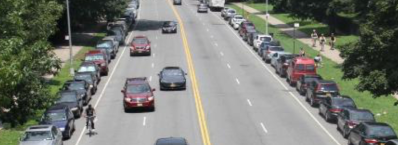Two-Way Protected Bike Path Sails Through CB6 Committee
 Image: NYCDOT
Image: NYCDOTEric McClure of Park Slope Neighbors files this report.
Last night, the transportation committee of Brooklyn Community Board 6 unanimously endorsed a plan by the Department of Transportation to calm traffic on Prospect Park West through a major street redesign.
The plan features the implementation of New York City’s first on-street, two-way, physically separated bike lane, which will run alongside Prospect Park on the east side of Prospect Park West, and will be protected by a four-foot striped buffer and a parking lane. In order to accommodate the new bike lane, Prospect Park West will be reduced from three south-bound travel lanes to two, and the remaining lanes will be narrowed to ten feet each.
The planned changes address two major issues: the need for northbound bicycle access on Prospect Park West, for which there has been strong demand, according to DOT Bicycle Program Coordinator Josh Benson; and a major problem with speeding, which has been a longtime concern of residents and neighborhood activists.
Preston Johnson, DOT’s project manager for the Prospect Park West redesign, highlighted the problems caused by the street’s current configuration. At nearly 50 feet wide and with three travel lanes, the street encourages high speeds and reckless driving, forces pedestrians to make long crossings, and lacks dedicated cycling space, despite a high volume of bicycle traffic. Prospect Park West’s existing vehicle volume, which peaks at about 1,100 cars per hour, can easily be accommodated by two lanes, Johnson said.
In field surveys last month, DOT found that more than 70 percent of the cars on Prospect Park West were exceeding the 30 mph speed limit, and at least 15 percent were traveling at 40 mph or faster. From 2005 to 2007, there were 58 reported crashes on Prospect Park West.
In addition to the the two-way bike lane and buffer, the street redesign will include concrete pedestrian refuge islands, which will significantly shorten the crossings at intersections, and extensive new landscaping under the DOT’s Greenstreets program. Parking spaces will be maintained along Prospect Park West with the exception of approximately two spaces at each signalized intersection.
The plan was enthusiastically received by the CB 6 transportation committee and an audience of about three dozen people. Board members raised some concerns about the lack of dedicated signalization for cyclists, especially those riding northbound. In a unanimously approved motion introduced by transportation co-chair Joanne Foulke, the committee asked DOT to include north- and southbound signals for cyclists, some daylighting measures, and dedicated drop-off zones in the final redesign. Roger Melzer, a 30-year Prospect Park West resident, was the only person to speak against the plan, saying that he feared the loss of a travel lane would create a "nightmare" of double-parking near the 9th Street park entrance.
Said Jeff Prant, a Park Slope resident, Transportation Alternatives
board member and long-time advocate for livable streets, "I never
thought I’d see the day when a proposal to remove an entire lane of
traffic would encounter virtually no objection."
The Board chairs would not entertain a question from a resident regarding the possibility of converting Prospect Park West to two-way traffic, in conjunction with a similar reconfiguration of Eighth Avenue, asking that the discussion be limited to the proposal on the table. DOT’s Benson, however, said that he thought such a change would create problems with additional signal movements at Grand Army Plaza, but he didn’t rule out the possibility of further design changes over the long term.
According to DOT, the Department of Design and Construction will likely begin implementing the Prospect Park West redesign in September, and the full build out would take a few months.
In addition to the Prospect Park West changes, DOT announced that it is planning to permanently close the 3rd Street park entrance to vehicles beginning next month. In conjunction with the closure, DOT will stripe new bike and pedestrian lanes into and out of the park at 3rd Street, with the intent of reducing conflicts between cyclists and pedestrians. DOT will also permanently close the vehicle exit at 16th Street and Prospect Park South, so that all cars entering the park at Grand Army Plaza will exit at Park Circle. The park’s West Drive is open just two hours each weekday, from 5 p.m. to 7 p.m.
DOT also presented a plan for a traffic-calming redesign on Baltic Street between Hoyt and Bond Streets, a very wide block that has been plagued by speeding. The plan involves the installation of a landscaped 10-foot median, three lanes of parallel parking (two on either side of the eastbound south side of Baltic and one on the westbound side), and pedestrian refuges at the intersections with Hoyt and Bond. DOT cited the redesign of the north end of Carlton Avenue as an example. DOT also plans to implement a Class III bike lane on this stretch of Baltic Street, with "sharrows" to indicate shared road space for cars and bikes.
